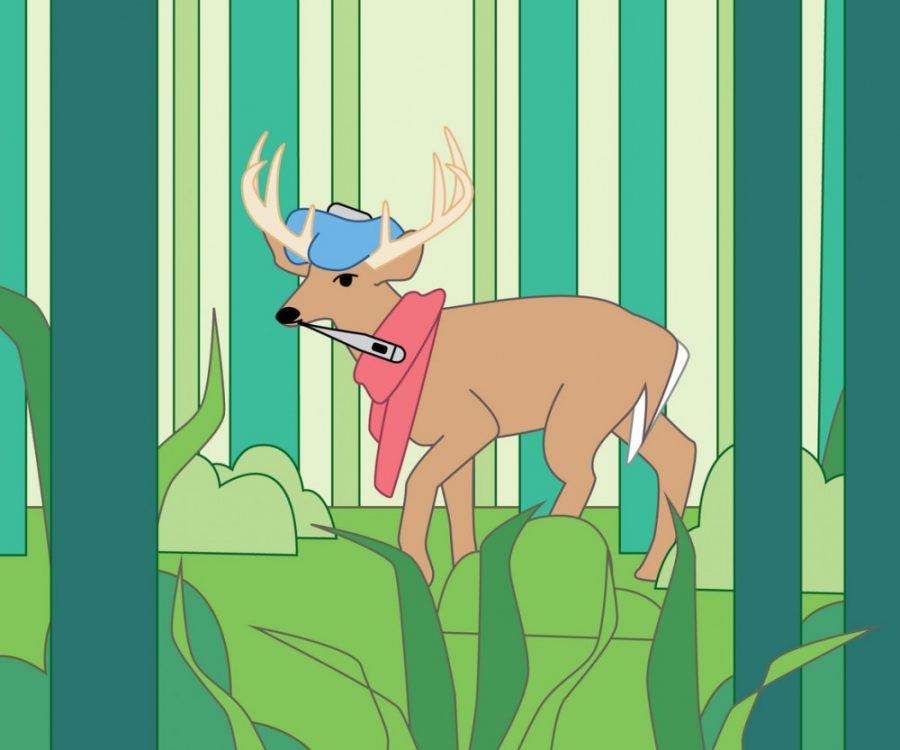Seeing inaction on the spread of a neurological animal disease, University of Minnesota researchers are ramping up a new program to bolster policy controlling the health emergency.
The Chronic Wasting Disease Response, Research and Policy Program, a University-led initiative announced March 19, intends to foster collaboration between hunters, legislators and researchers to combat the threat of CWD. Public concern on the issue was reignited in January, when a wild deer with CWD was discovered in Crow Wing County, the state’s first case outside of Southeastern Minnesota.
CWD is a neurological disease in the same family as mad cow disease. It has been found in various cervids, such as deer and elk, and is always fatal. Symptoms, such as severe weight loss, may not show for up to three years while the deer is continually spreading the disease.
The disease is transferable through bodily fluids and antler velvet. Research shows it can also transfer through plants and may stay in the soil for years.
Officially declared an emergency by the Department of Agriculture in 2001, CWD has now been found in at least 25 states, including Minnesota.
“It’s important to consider the public health risk,” said Cory Anderson, a graduate student in the program. “Regardless of whether this can transmit to humans, it is currently a wildlife crisis.”
The effects of CWD on humans, if any, are unknown. There have been no reported cases.
An ongoing study out of Canada, yet to be peer-reviewed, found CWD in macaque monkeys after they ate CWD-infected meat, suggesting the disease could spread to animals that are genetically similar to humans. A 2017 report from the Alliance for Public Wildlife estimates as many as 15,000 CWD-infected deer are consumed by people each year.
Michael Osterholm, director of the University’s Center for Infectious Disease Research and Policy, leads the program.
“It is probable that human cases of chronic wasting disease associated with consumption of [CWD]-contaminated meat will be documented in the years ahead,” Osterholm testified to the Minnesota House of Representatives in February. “It’s possible that the number of cases will be substantial.”
Anderson said misinformation hinders control of the disease. He said characterizations such as “zombie-deer disease” detract from the seriousness of the problem.
“There is great research out there right now that points to best practices,” Anderson said. “At this point, we are not seeing public policy accept these research answers.”
Anderson, a hunter himself, said hunters are the best tool for controlling deer populations. If the number of hunters decline because of the disease, controlling it will only get tougher.
“You have 200,000 [deer] that get harvested every year in Minnesota,” Anderson said. “If half of your hunters drop off, that increases your deer populations and essentially amplifies the problem.”
Brenda Hartkopf, a member of the Minnesota Elk Breeders Association and an elk farm owner near Howard Lake, Minnesota, said she welcomes anything to address the spread of the disease. She said the threat to farms like hers comes from wild deer and carcasses moved by hunters.
“There is just a lot of gray area,” Hartkopf said. “A lot of hunter education that could take place. They don’t realize the ramifications of what is happening.”
Dr. Jeremy Schefers, assistant professor in the Department of Veterinary Population Medicine, testified before the House of Representatives in February, stressing the need to take action.
“I’ve just watched it march across North America without anything getting in its way,” Schefers said. “I think it’s time to start fighting back.”
















